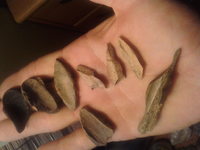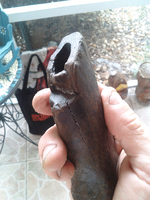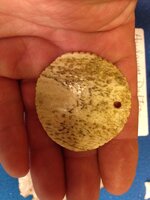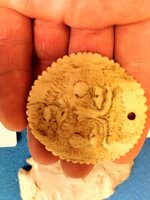rivernomad44
Full Member
- Feb 18, 2012
- 145
- 45
- Primary Interest:
- Relic Hunting
Upvote
0
Unless there's some sign of use or wear the doesn't show in the photos, you have just some bones. Although it does look like some were broken/split for the marrow.
Harry Pristis said:I agree with 'T Witko' . . . unaltered bones.
One is a deer ungual. <img src="http://www.treasurenet.com/forums/attachment.php?attachmentid=666475"/> .









They ate the marrow and that's easy to get at, as GatorBoy said. They also broke down and boiled smaller fragments of bone to render the grease out of the bone itself. Several hours of boiling and skimming off the grease would leave a lot of small bone fragments and would also soften the bone pieces up. It is my opinion that without definitive work showing on small pieces of bone, they are just food refuse. But anything can be used as a momentary tool and show little or no work. Work on bone fragments are cuts, abradings, even chips. If you are smashing bone to boil for grease there will be a lot of very similar looking fragments. Bone is so easy to work, compared to shell or stone, you'll see the work unless it's one of those expedient tools.







The middle bone on your bottom row is like one that I have held on to. Mine is still white in color. Does that mean that the bone I have is not fossilized, and more than likely I have road kill in a box? If so, she has got to go!
Harry Pristis said:"Fossilized" is a near meaningless term. The term is often substituted for "mineralized" in describing a bone or tooth. But, fossilized doesn't always equate to mineralized because many fossils are not impregnated or replaced by minerals.
Bone is primarily composed of hydroxyapatite and collagen. Hydroxyapatite is an inorganic compound of calcium, phosphate, and hydroxide which is organized in a crystal latticework that gives bone (and teeth) structural rigidity. It preserves well as a fossil under some conditions.
Collagen is a fiberous protein that serves as connective tissue in bones and muscles. It does not preserve well in a fossil. As collagen decomposes, it may be replaced in the hydroxyapatite latticework by minerals from the depositional environment (e.g. silica dioxide dissolved in groundwater).
Bone reinforced with exogenous minerals is said to be mineralized.
A 'burn test' or 'match test' will usually indicate whether there is collagen remaining in a bone -- scorched collagen has an awful smell. Teeth - dentin and enamel - contain hydroxyapatite, but don't contain collagen, so the 'burn test' on a tooth would be a waste of time.


Man Harry! You know your anatomy. I see now that you are a reliable info source on bone, shell, and antler. Do you mind telling me what makes you think my pendant is turtle shell? Sorry if I got off on the wrong foot with you. I'll post the pic again incase you have forgotten it. Thanks!!
View attachment 667226
Harry Pristis said:After following the other thread, and after doing some shopping on the www, I believe that your pendant is not turtle bone.
I think your pendant is probably water buffalo bone carved in Indonesia in 1994 (+/- ten years). The face is distinctly oriental, and that's a common carving medium in SE Asia.
I do know that box turtles were the primary food source around here. A real archeologist told me this, and it makes sense. Turtles are a pretty easy catch.
Harry Pristis said:THE primary food source?? That sounds dubious. What I have read (though I don't remember where) is that it is risky to eat box turtle because of their fondness for fungi, including the poisonous varieties. The toxins may be present in the box turtle's flesh. Native Americans did enjoy softshell turtles, though.